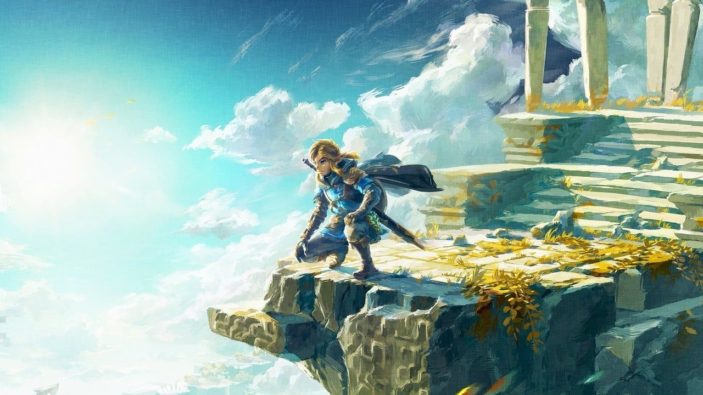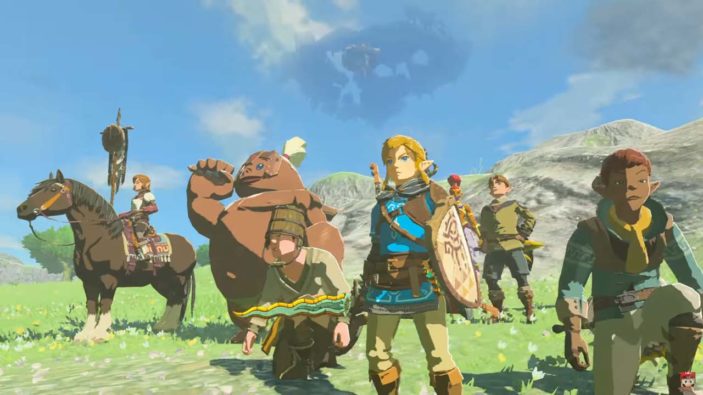
I will admit that it’s been a while since I last played The Legend of Zelda: Breath of the Wild. But in many ways, after all these years, it still held the title of the best game I had played on the Nintendo Switch; until now. The Legend of Zelda: Tears of the Kingdom simply improves on its predecessor in almost every way, bringing with it a larger open world, new and exciting mechanics and a riveting story that rivals even the best tales the franchise has to tell.
While I had my doubts about the possibilities and challenge of improving on what was already one of the best games every made, Tears of the Kingdom has proved that much like the ageing hardware, the Zelda franchise has an astounding amount left to give.
The Boy in the Green Tunic
I’ll do my best to talk about Tears of the Kingdom’s story without spoiling Breath of the Wild, but I feel as though certain talking points will lead to minor spoilers. In that case, please feel free to head to the next paragraph for my broader thoughts on the narrative. Tears of the Kingdom picks up a few years after the events of Breath of the Wild, in which Link and Zelda have joined forces. Their introduction sees them accidentally unleashing a certain villain (wink wink), along with an event known as the “Upheaval”, awakening an ancient race known as the Zonai, in addition to unleashing new floating structures that sit in the sky. While it’s a lot to take in at first, Tears of the Kingdom’s story soon falls into a familiar rhythm of rescuing Zelda and defeating a familiar evil, all while addressing the return and intentions of a long-dormant alien race. Given Tears of the Kingdom’s rather familiar narrative structure, I certainly appreciated this latter inclusion, as the Zonai add a newfound sense of weight and scale to the overall story.

Tears of the Kingdom’s narrative structure will most likely feel familiar to most fans of Breath of the Wild. After the introduction, players are thrust out into the open world. While important story missions and objectives are highlighted on your map, you can indeed power immediately through to the final confrontation, should you know where to look. While I wouldn’t recommend that in the slightest, the recommended route throws an incredible amount of variety your way, presenting environmental puzzles, unlockable powers and boss battles through both new and traditional dungeons, that make most actions in Tears of the Kingdom feel both important and engaging. You’ll more than likely find yourself lost in the grand sense of scale at certain points, but it all feels meaningful, as much of the game’s lore is expanded upon through simple conversations with NPC characters.
As Above, So Below
This time around, Link is able to explore both the sky and the land, with Breath of the Wild’s original version of Hyrule seemingly remixed with new areas to explore. However, thanks to the Zonai’s drastic “Upheaval”, Link can now explore the skies like never before, jumping between floating rock structures, huge and unique islands full of their own collectables and hidden areas. Players will admittedly spend a significant portion of the game’s opening hours upon these floating structures, which presents a whole new challenge when it comes to traversal. As a result, you’ll need to discover a number of unique ways to traverse between the land and the sky, which never loses its grand sense of scale. Even travelling between objectives feels like a puzzle all on its own, as you navigate the lend and even returning weather elements, which require their own preparation and equipment.
Link can also now explore the Depths, an underground labyrinth of caves and tunnels that reach almost as far as the map of Hyrule itself. It’s pitch black throughout, meaning you’ll have to collect a bunch of Brightbloom Seeds to light the way. This initially scared the hell out of me, given it opens up an entirely new layer of an already massive open world. But the less I say beyond this point the better. Either way, it stacks the overall offering of side content so high, I’m surprised it didn’t crumble like a massive Jenga tower.

Beyond the main story and personal exploration, Link can also discover Shrines. These unique structures a highlighted with a green halo, and serve as a small challenge required to unlock Link’s new and unique powers. You’ll unlock a few of these in the opening hours, all of which come in handy when exploring. While I won’t spoil all of them, the new Ascension power basically allows you to zip up through structures that float above you without the need to climb perilous heights, which feels like a blessing after a few hours. The Fusion ability also adds to both exploration and combat, as it essentially allows you to fuse weapons and environmental objects together. The weapon durability system returns, but almost anything can be fused together, giving players a virtually endless list of options to experiment with. I personally liked infusing most of my weapons to a boulder, which then allows you to smash through certain walls.
Each power is easy to use with the tap of the shoulder button, and are ultimately always relevant and necessary. Zonai Devices are also introduced into the mix, providing Link with new ways to infuse existing environments structures with ancient technology, from fans to gliders, which usually interwoven with exploration. These are stored in your inventory and can be used at any time, making them a total lifesaver when all seems lost.
The Thrill of the Fight
In true Zelda fashion, Link will also be able to explore dungeons, which feel like a fresh take on Breath of the Wild’s similar offerings. Dungeons will all take after a particular theme, whereas this time around, bosses will take the form of a number of different enemy types, as opposed to The Divine Beasts, which ultimately took away from Breath of the Wild’s variety in terms of enemy types. While I won’t spoil those new types here, I can appreciate their approach, as some come at you in numbers, crawling on ceilings and block your surroundings, while others intentionally predict your manoeuvres to corner you in. These dungeons will feel familiar to fans, even if it’s a joy to see that sense of variety heightened.

I could honestly commend Tears of the Kingdom for hours on end for its open-ended nature and sheer variety, but one of the game’s biggest surprises came from its performance. Before we go any further, let’s address the elephant in the room. Yes, the Nintendo Switch is six years old. Yes, games don’t run in 4K or regularly provide 60fps frame rates. While Tears of the Kingdom runs in 1080p and at 30fps, textures can sometimes look muddy and the frame rate can drop at certain points, usually in chaotic combat scenarios or when giant objects are being utilised during puzzles. That being said, Tears of the Kingdom runs relatively well, considering the sheer scale of its interconnected open world.
The ability to bounce between the sky, land and the depths is relatively seamless and I honestly cannot speak to any glitches or annoying bugs that bring the experience down in any meaningful way. If this hardware was date in any way, Tears of the Kingdom has showed us all that there’s still life left in this hardware. It’s also worth mentioning here that the soundtrack is fantastic, filled with many familiar themes and tunes, wrapped in a sweeping and generally epic orchestral score.
Final Thoughts
For the longest time, this review had intimidated me. For something I have enjoyed so much, it felt like a relatively insurmountable task to be able to put into words. But for all I have mentioned throughout this review, what follows encapsulates everything you have read. The Legend of Zelda: Tears of the Kingdom improves on its predecessor in almost every way, providing gamers with one of the greatest sequels ever made.
While new and emerging fans will appreciate Tears of the Kingdom for its expansive nature, unique gameplay systems and intriguing narrative, fans of the franchise can rejoice in knowing that The Legend of Zelda franchise stands as tall as it once did, still the undisputed king of everything within the past six years that the Nintendo Switch has offered.
FIVE STARS (OUT OF FIVE)
Highlights: Detailed and expansive open-world; Intriguing narrative; New powers and dungeons; True freedom in terms of progression and exploration
Lowlights: Performance sometimes struggles on ageing hardware
Developer: Nintendo EPD
Publisher: Nintendo
Platforms: Nintendo Switch
Available: Now
Review conducted on Nintendo Switch with a pre-release code provided by the publisher.
